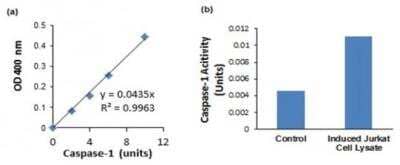Caspase-1 Activity Assay Kit (Colorimetric), Novus Biologicals
Bio-Techne includes Novus Biologicals | Catalog # NBP2-54815
Key Product Details
Sample Type & Volume Required Per Well
Cell and tissue lysates
Product Specifications
Kit Type
Activity Assay Kit (Colorimetric)
Reactivity
Human, Mouse, Rat, Mammal
Description
Simple and convenient colorimetric assay to measure Caspase-1 activity within 1-2 hrs. Detection method: Absorbance at 400 or 405 nm. Applications: Detect early/middle stages of apoptosis; differentiate apoptosis from necrosis.
This product is manufactured by Abcam and distributed by Novus Biologicals. (Abcam Catalog Number: ab273268-25)
This product is manufactured by Abcam and distributed by Novus Biologicals. (Abcam Catalog Number: ab273268-25)
Scientific Data Images for Caspase-1 Activity Assay Kit (Colorimetric)
Caspase Colorimetric Assay Kit [NBP2-54815] - (a) Active recombinant caspase-1 standard curve. (b) Caspase-1 activity in 1 ug uninduced and induced Jurkat cell lysate. Assay was performed according to the kit protocol.
Kit Contents for Caspase-1 Activity Assay Kit (Colorimetric)
- 2X Reaction Buffer
- Cell Lysis Buffer
- Dilution Buffer
- DTT (1 M)
- YVAD-pNA (4 mM)
Preparation and Storage
Shipping
The product is shipped with polar packs. Upon receipt, store it immediately at the temperature recommended below.
Stability & Storage
Store at -20C.
Background: Caspase-1
Given the role of IL-1beta in inflammation, it makes sense that many diseases and pathologies have been associated with dysregulation of caspase-1 activation and the inflammasome (3, 4). The inflammasome is a multiprotein complex comprised of Nod-like receptor (NLR) family members and the adapter ASC (apoptosis-associated speck-like protein containing a CARD) which are crucial for capase-1 activation (3-5). For instance, the neuronal apoptosis inhibitory protein (NAIP)/NLRC4 inflammasome has been associated with colorectal cancer, breast cancer, and glioma pathogenesis (5). Caspase-1 activation and mutations in the inflammasome have also been linked to Chron's disease and Alzheimer's disease (4). In addition to immune and inflammatory related disorder, the inflammasome has been linked to metabolic and obesity related disorders including diabetes and cardiovascular disease (6). Finally, caspase-1 deficient mice exhibit enhanced epithelial cell proliferation in the colon, increased tumor formation, and reduced apoptosis (1). A more thorough understanding of the inflammasome-caspase-1 signaling pathway will be important for understanding disease pathology and potential therapeutic development.
Alternative names for caspase-1 includes CASP1, CASP1 nirs variant 1, EC 3.4.22.36, ICE, IL-1 beta-converting enzyme, IL1BC, IL1BCE, IL1B-converstase, interleukin-1 beta convertase, and p45.
References
1. Shalini, S., Dorstyn, L., Dawar, S., & Kumar, S. (2015). Old, new and emerging functions of caspases. Cell death and differentiation. https://doi.org/10.1038/cdd.2014.216
2. Chang, H. Y., & Yang, X. (2000). Proteases for cell suicide: functions and regulation of caspases. Microbiology and molecular biology reviews: MMBR. https://doi.org/10.1128/mmbr.64.4.821-846.2000
3. Vanaja, S. K., Rathinam, V. A., & Fitzgerald, K. A. (2015). Mechanisms of inflammasome activation: recent advances and novel insights. Trends in cell biology. https://doi.org/10.1016/j.tcb.2014.12.009
4. Franchi, L., Eigenbrod, T., Munoz-Planillo, R., & Nunez, G. (2009). The inflammasome: a caspase-1-activation platform that regulates immune responses and disease pathogenesis. Nature immunology. https://doi.org/10.1038/ni.1703
5. Kay, C., Wang, R., Kirkby, M., & Man, S. M. (2020). Molecular mechanisms activating the NAIP-NLRC4 inflammasome: Implications in infectious disease, autoinflammation, and cancer. Immunological reviews. https://doi.org/10.1111/imr.12906
6. Pham, D., Park, P. (2020). Recent insights on modulation of inflammasomes by adipokines: a critical event for the pathogenesis of obesity and metabolism-associated diseases. Archives of Pharmacal Research. https://doi.org/10.1007/s12272-020-01274-7
Alternate Names
CASP1, Caspase1, ICE
Gene Symbol
CASP1
Additional Caspase-1 Products
Product Documents for Caspase-1 Activity Assay Kit (Colorimetric)
Product Specific Notices for Caspase-1 Activity Assay Kit (Colorimetric)
This product is for research use only and is not approved for use in humans or in clinical diagnosis. Kits are guaranteed for 6 months from date of receipt.
